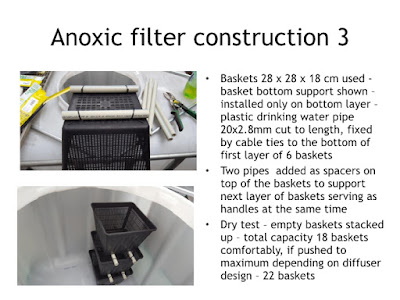Dear Dr.
Novak,
Syd aka
Manky Sanke suggested me in his response to forward this e-mail also to you -
as you are following up on new developments with Your great invention - so hope
you may find it an inspiring application of Your great anoxic filter invention
into quite universal indoor - outdoor setup while minimizing footprint of it.
I have
attached short power point with couple pictures and few comments hopefully
helpful for someone else who may face the same space constraints as I did.
Though I understand the principle of anoxic filter operation quite well given
my degree in biochemistry and biotechnology background (though I am out of it
for over 30 years by now) I am keen to see how it will work in my particular
setup - and if by a chance it may also help to reduce DOC as well as I have
seen commented on in one of the posts on internet. If it would do it, than in
reality only RDF followed by anoxic filter might be all what would be needed -
no protein skimmers, moving bed bio-filters etc. needed any more - wow - sounds
like dream come true finally.
Thank you.
Milos
Laznicka - life long aquarium hobbyist and rather novice Koi keeper.
Hi Syd,
Hope this
e-mail finds you well.
I could not
resist - after reading so great reviews - and your great articles about the Dr.
Kevin Novak's Anoxic Filter invention to try to build one and see how it works
in real life in my setup.
As my wife
did not allowed me to build third pond in our garden - after 9.000L original
golden fish and Water Lilly pond, newer 24.000L Koi pond the third would be for
anoxic filter - instead I had to look for minimized footprint solution - so I
used 600L ICB tank with 40cm opening and built in drain valve - produced
commercially - and sold either as new (for 192 Euro here) or used one for half
the price - this design allows for placing it both outdoors or indoors as
required - as I have not found similar design anywhere on the internet so far,
I thought you might want to share it with other Koi hobbyists facing similar
problem - not enough space / missing construction permit for open anoxic filter
in their garden.
I am
attaching short presentation with photos and commentary added - should be
self-explanatory.
Parameters
of my pond:
Finally
precisely measured volume - 24.000L
Never had problem
with NO2 (0) or NO3 (under 20), pH 7, GH 4-5 deg., KH 3-4 deg
I have
netted out of it about 68 gold fish this Spring to make room for more koi - now
total of 21 Koi ranging from 10cm to 50cm.
I am heating
over the winter (DEC - FEB) using 3kW flow thru electric heater set at 7 deg.
Celsius - outside of DEC - FEB I use 5kW heat pump - since March running at 15
degrees Celsius and MAY - SEP at 23 deg. Celsius - with separated pumped
circuit - shut down in DEC - FEB.
So now I am
interested to see how the anoxic filter works - and if eventually I would be
able to shut down my Nexus 220 original filter - and depend solely on RF
followed by anoxic filter only.
I will
report how is the water quality doing - so fat almost gin clear - RDF does
really great job in mechanical filtration of my pumped setup - I do not need to
clean my Nexus 220 2 - 3 times per week as prior I installed the RDF earlier
this Spring - now I do it only once per month.......can only recommend to
everyone - getting the detritus and fallen leafs out of the water immediately -
passing cleared water into the biochemical filtration of Nexus 220 (with 150L
of K1) and the newly added anoxic filter with up to 18 biocenosis baskets.
Hope this
will help other Koi hobbyists to get into anoxic filtration using minimal
footprint available.
In response to Milos letter:
Hello Milos,
After
reading your e-mail and looking at your Anoxic PDF file I realize that the
Anoxic Filter has come a long way in innovated ideals and better use of its
resources. I will be using a
smaller version of the Anoxic Filter in my SCA 50 aquarium sump as soon as
weather permits. Using an Anoxic
Filter with aquariums will be the next step in water quality that most hobbyist
have never experience.
It’s nice to
see that the Anoxic Filter is being embraced more by the pond hobby than it was
several years ago when it was introduced to the hobbyist.
So many thought because of not understanding many of the words and terms I used
or the science behind the system, that it would never be a substitute for
conventional filtration systems. Syd, over in the UK has done so much in
getting people excited about the filtration system and with his knowledge and
perceptive writings on the subject about the Anoxic Filtration System that I don’t
think it would be as well embraced by individuals as it is today if I wasn’t
for him.
Though I
have never personally met Syd (AKA: Manky Sanke) or the many other hobbyist
(Dr. Franco from Italy) like yourself that now uses and write about the Anoxic Filtration
System, as a scientist, how does one express their appreciation to others for
their time spent innovating the system and the countless photos they have taken
and sent me. You along with others set a new bar with the Anoxic Filter that I
thought would never be reach. It is very much appreciated on my part to those
that have given so much faith in the system.
Cheers,
Kevin















